Hello gardeners, are you interested in growing desert rose plants in your home garden? Well, you are in the perfect place to learn about it. Desert roses are one of the most popular houseplants. They are easy to take care of, and they have beautiful flowers. If you want to grow desert roses, there are certain things you need to know. In this post, we will discuss how to grow desert roses. We will cover topics such as varieties, soil, planting, pruning, fertilizers, and care. After reading an entire article, you will know everything about growing desert roses.
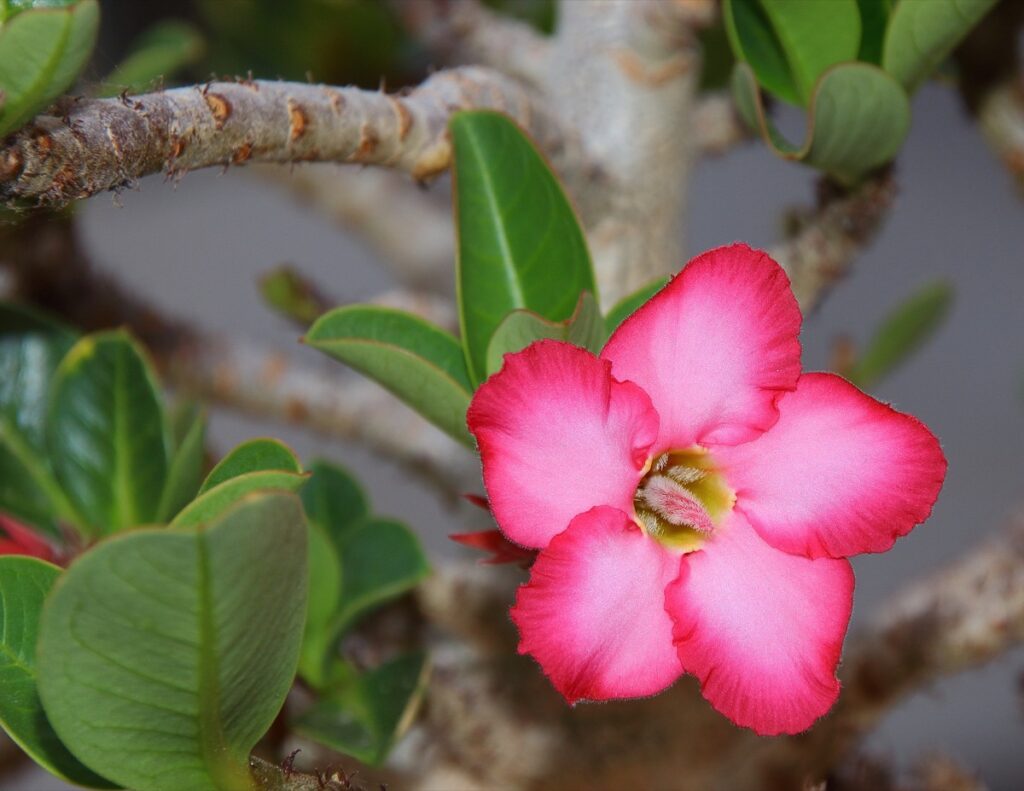
How to grow desert roses
What is a desert rose?
Desert roses are beautiful, unique flowers that add to any home or garden. They come in various colors and sizes and can be grown in most climates. Desert roses require very little care and can thrive in almost any type of soil. They are drought-tolerant and do not need much water to survive. However, they do need full sun to bloom properly. When planting desert roses, choosing a location with plenty of sunlight is essential.
You can plant desert roses in the ground or pots. Plant them at least two feet apart so they will have enough room to grow. Usually, pruning is not necessary for desert roses, but you may want to trim off any dead leaves or flowers. You can also fertilize desert roses once a month during the growing season with a low-nitrogen fertilizer. With just a little care, your desert rose will thrive and provide you with beautiful blooms for years to come!
Different varieties of desert roses
Desert roses come in many different varieties, each with its unique appearance. The most common varieties are the Alba, which has white flowers; the Cinnabarina, which has reddish-orange flowers; and the Rubra, which has red flowers. There are also variegated varieties that have both white and red flowers. The Alba variety is the most heat resistant and can tolerate temperatures up to 120°F (50°C).
In case you missed it: Vertical Strawberry Farming: A New Way to Increase Your Income and Yield
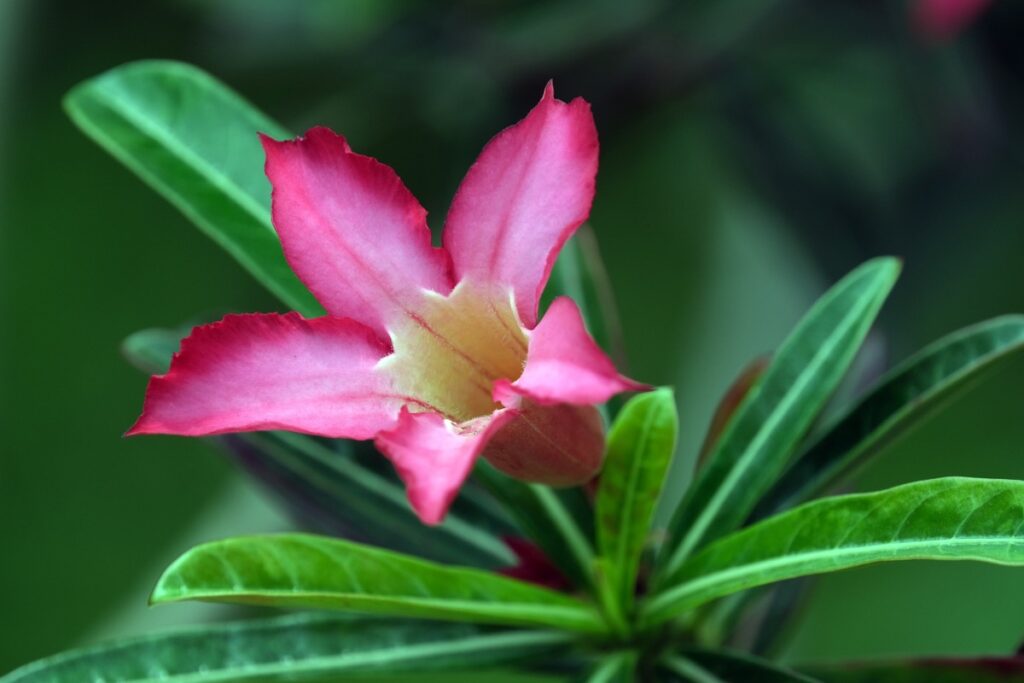
It is also the most drought-tolerant of all the varieties. The Cinnabarina variety is not as heat resistant as the Alba but can tolerate temperatures up to 100°F (38°C). It is also more tolerant of shade than the other varieties. The Rubra variety is the least heat resistant and can only tolerate temperatures up to 80°F (27°C). However, it is the most cold-tolerant of all the varieties and can withstand temperatures as low as 20°F (-6.6°C).
When choosing a desert rose for your garden, selecting a variety that can withstand the temperature extremes in your area is vital. Once you have selected a suitable variety, you must provide it with well-drained soil and full-sun exposure. In areas with hot summers, desert roses will benefit from afternoon shade. Desert roses are usually propagated by rooting stem cuttings taken from healthy plants. The cuttings should be taken from new growth six to eight (6 to 8) inches long and contain at least two leaves.
Soil requirement for desert roses
Desert roses are beautiful, fragrant flowers that add a touch of luxury to any garden. They are native to arid regions and have adapted to survive in harsh conditions. As such, they are very drought-tolerant and can thrive in poor-quality soil. When growing desert roses, the most important thing is to choose suitable soil. Desert roses need a fast-draining, sandy soil that is low in fertility. This soil drains quickly and does not hold onto nutrients, which is ideal for desert roses.
In case you missed it: How to Grow Columbine Flowers: A Guide to Propagation, Planting, and Care
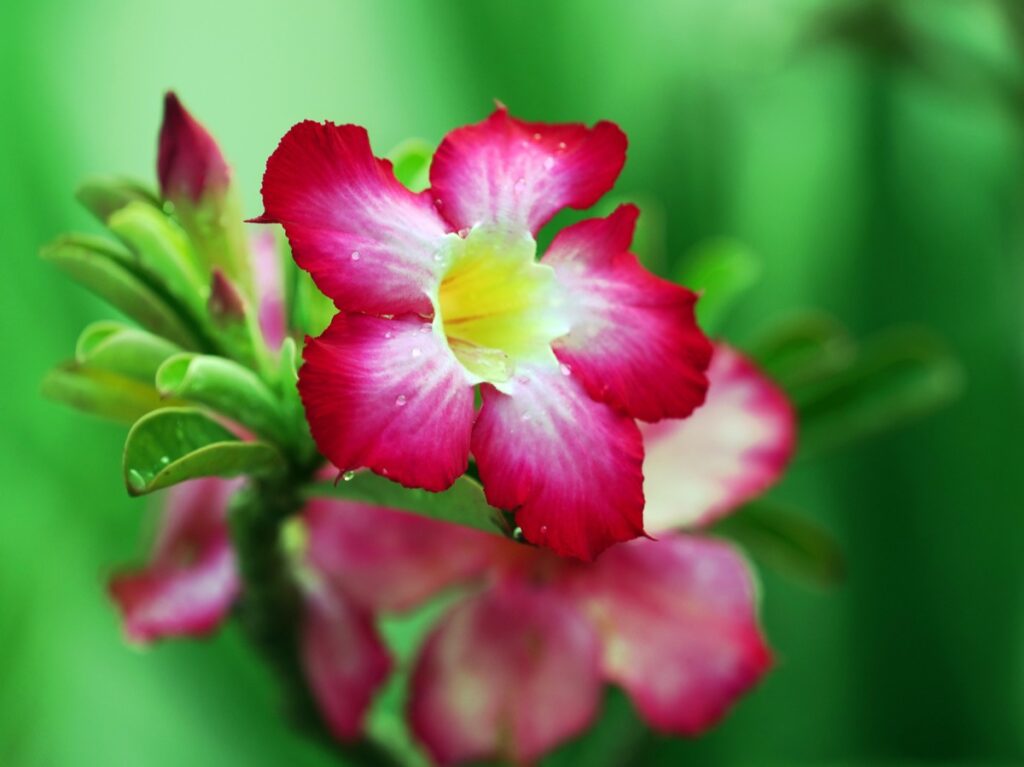
If you live in an area with clay soils, it is best to avoid them as they will compact around the plant’s roots and suffocate it. Instead, look for a sandy loam or cactus mix with plenty of grit. Once you have chosen suitable soil, it is essential to plant your desert rose in a sunny spot. Desert roses need at least six hours sunlight each day to bloom well. If you live in a hot climate, plant them in an area that gets afternoon shade to prevent them from getting too much heat.
Regarding watering, desert roses are drought-tolerant and can survive on very little water. However, they will flower better if given a deep watering once every two weeks during the spring and summer growing seasons. Allow the water to penetrate deeply into the soil so the roots can access it.
How to grow desert rose plants from cuttings
- Choose a healthy stem with several leaves, and cut it just below a leaf node with a sharp knife or pruning shears. The cutting should be about 4 to 6 inches long.
- Remove the bottom leaves from cuttings.
- Dipping the cuttings (end of the stem) in rooting hormone powder or gel is best. It is time to plant cuttings in a pot filled with well-draining cactus or succulent potting mix.
- Water the pot well, then place it in a warm, sunny spot.
- Keep the soil moist but not water-logged, and in 30 to 45 days, you should see new growth appearing on your desert Rose cutting.
- Once the plant is established, reduce the watering frequency.
Planting desert roses
Desert roses are a type of rose native to the arid regions of North Africa and the Arabian Peninsula. They are well adapted to these hot, dry climates and can be found growing in the wild in many desert locations. Desert roses are also popular as ornamental plants, and they are grown in gardens all over the world. Various varieties of desert roses come in a wide range of colors, including white, pink, red, and yellow.
In case you missed it: How to Grow Rajnigandha (Tuberose): Soil, Propagation, Flowering Season, Planting, and Care
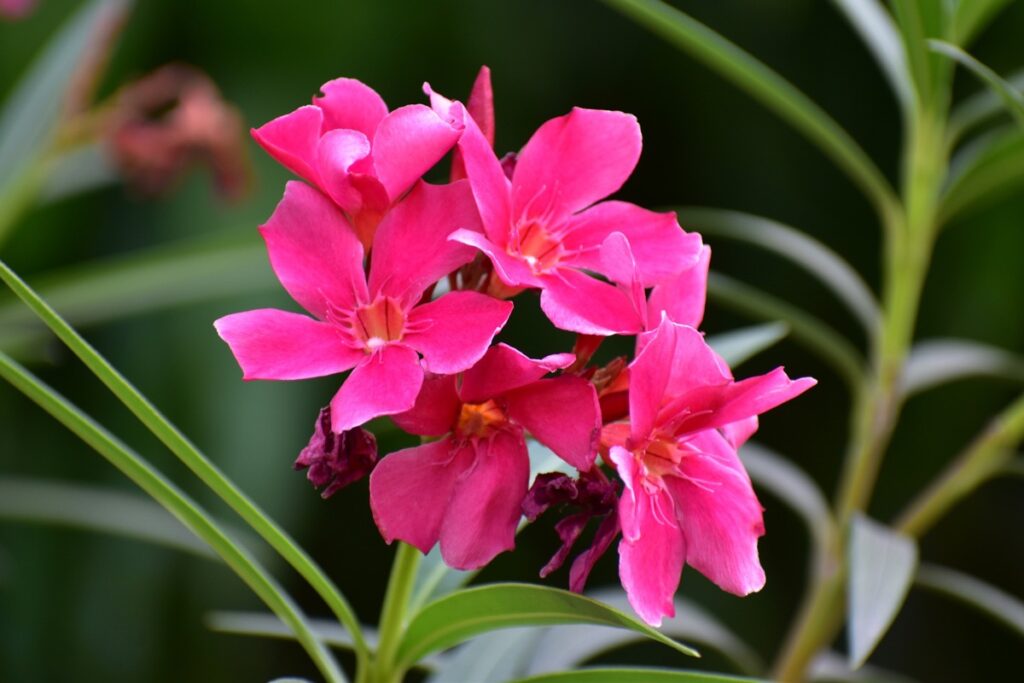
The most common variety is the Rosa gossypiifolia, also known as the cotton or Egyptian rose. Desert roses need well-drained soil that is high in organic matter. They will not tolerate wet or heavy soils. When planting desert roses, use a mix of one-part sand to two parts loam. This will provide the perfect drainage and moisture retention for your plants. Desert roses should be planted in full sun for best results.
However, they will tolerate some light shade if necessary. The best time to plant desert roses is in late winter or early spring, with no frost danger. Once your desert roses are planted, you must water them regularly during their first growing season to help them establish deep roots. After that, they will be pretty drought-tolerant and will only need occasional watering during extended periods of dry weather.
Pruning requirement for desert roses
Pruning desert roses is an essential part of their care. It helps to promote new growth and keeps the plant healthy. When you prune, cut the stems back to the first set of leaves. This will encourage new growth from that point. Prune desert roses in the spring or early summer before they begin to bloom.
Fertilizer requirement for desert roses
While desert roses can grow and thrives in various soils, they prefer sandy, well-drained soil. They are also drought-tolerant and do not need much fertilizer. Too much fertilizer can burn the roots of desert rose plants. A light application of balanced fertilizer once a month is required to keep desert roses healthy.
In case you missed it: India Flower Planting Calendar: Month-wise Garden Sowing Chart, Dates Guide for Winter, Summer, and Rainy Season
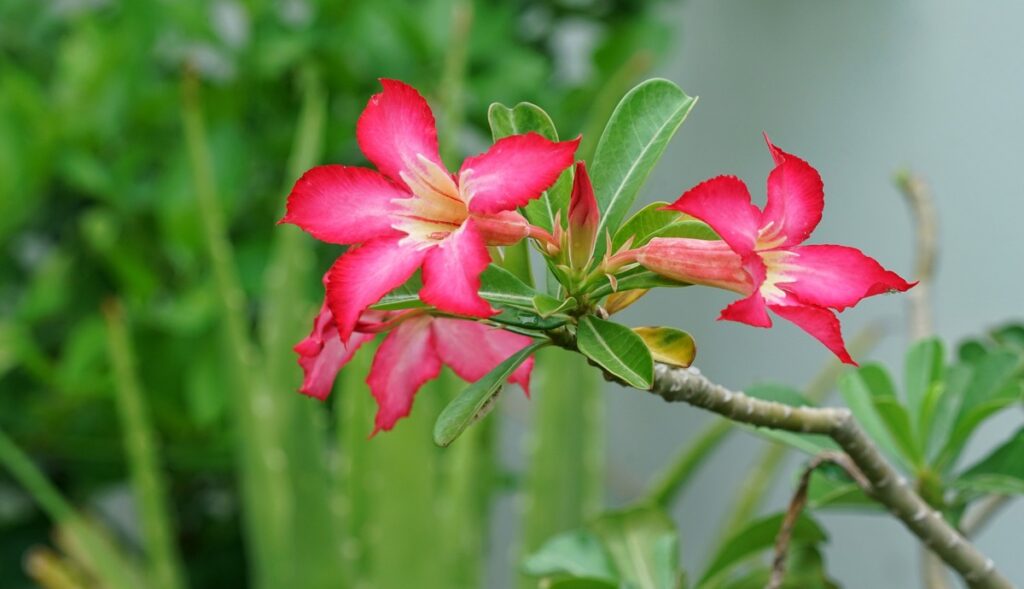
Plant care for desert roses
Assuming you have already chosen a location and prepared the soil, you must water your desert rose thoroughly before planting. It is best to plant in the morning so the roots can take advantage of the cooler temperatures and avoid heat stress. Digging a hole deep enough to accommodate the root ball of your plant is essential. When it’s finally in place, ensure the top is level with the ground. Gently loosen any tightly wound roots before placing the plant in the hole. Make sure to Backfill with soil without burying the stem.
It is recommended to water again after planting. Once established, desert roses are relatively drought tolerant; however, they will perform best if given regular water during extended periods of heat or when flower buds are forming. A general rule of thumb is to water your desert rose plants with 1 inch of water weekly. Apply water at the base of the plant rather than overhead to minimize evaporation and foliar disease. Fertilize sparingly; too much fertilizer can promote excessive leaf growth at the expense of flowers.
Use a balanced fertilizer such as 10-10-10 according to package directions, or consult your local horticulture department for specific recommendations based on your soil type. Apply fertilizer monthly during active growth periods during spring and summer but not during fall and winter dormancy. Pruning is generally unnecessary except removing dead or damaged branches of desert rose; however, you can shape plants if desired by selectively removing new growth after flowering.
In case you missed it: How to Make Rose Plants Bushy and Flowers Bigger: Propagation, Fertilizers, Pruning, Planting, and Care
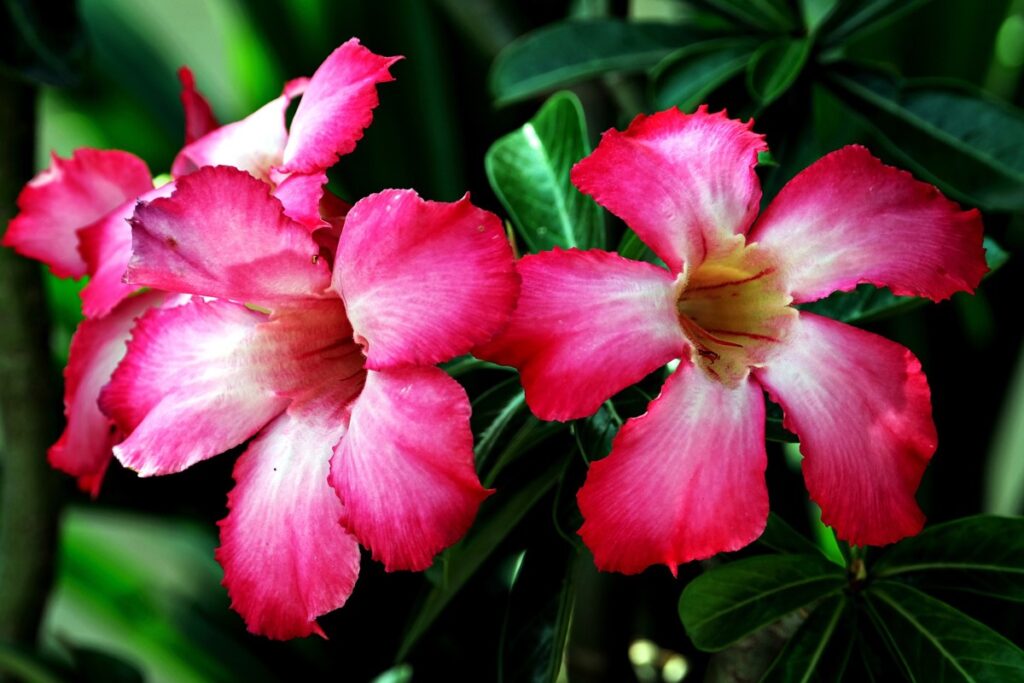
Conclusion
Desert roses are an excellent addition to any home or garden; with the proper care, they can thrive for many years. Our guide on how to grow desert roses has given you all the related information you need to get started. Remember to choose a variety of roses suitable for your climate, prepare the soil properly, and plant in an area with plenty of sunlight and water.
- Profitable Village Farming Business Ideas in 2024
- High-Yield Aquaculture: Fast-Growing Fish for Farming
- Effective Fish Pond Construction Techniques for Beginners
- Irrigation and Water Management in Pineapple Farming
- Blossom to Harvest: Mastering Flowering and Pollination in Papaya Farming
- Pig Fattening Essentials: From Selection to Sale for Beginners
- Raising Wagyu Cattle: A Complete Guide for Premium Beef Production
- Soil Types and Their Water Holding Capacity
- Optimizing Irrigation Schedules for Coconut Groves for Enhanced Yield
- Espresso Your Garden: Coffee Grounds for Healthier Acid-Loving Plants
- The Best Soil Mix for Snake Plants: How to Mix Your Own Snake Plant Soil
- Green Thumb Success: Expert Tips for Cultivating Greenhouse Beans All Year Round
- Bloom All Year Round: The Ultimate Guide to Indoor Hyacinth Care
- Eco-Friendly Gardening: How to Make Liquid Fertilizer from Kitchen Waste
- Ultimate Guide to Grow Anise in Pots: Explore Seed Propagation to Harvesting
- Guide to Raising Chester White Pigs: Discover Breed Facts to Growth Management
- Mastering the Elegance: The Ultimate Guide to Weeping Cherry Tree Care, Planting, and Maintenance
- Ultimate Guide to Planting Garlic in Grow Bags: Growing Strategies for Beginners
- How to Fix Spider Plant Leaf-Related Problems: Natural and Organic Remedies
- 10 Reasons Why Your Tulsi Plant is Shedding Leaves: Home Remedies and Solutions
- Optimizing Growth and Yield: The Advantages of Palm Bunch Ash Fertilizer
- Utilizing Neem Oil Extract as a Natural Pesticide for Hydrangea
- From Soil to Harvest: Various Ways in Which Farmers Can Use AI Tools
- Steps to Encourage and Induce Citrus Flowers: A Comprehensive Guide
- How to Fix Snake Plant Leaf-Related Issues: Natural and Organic Remedies
- Transform Your Garden into a Fragrant Oasis with Raat Ki Rani (Night Blooming Jasmine)
- Discover the Ideal Chicken Breeds for Philippine Farms
- How to Create a Poultry Egg Farm Business Plan for Profits
- Grow Lemon Cucumbers Like a Pro: Insider Techniques for Bountiful Yields
- Ultimate Guide to Caring for Your Pink Princess Philodendron: Tips for Thriving Variegation
- Areca Nut Profit Per Acre: Calculating Yield and Cost of Cultivation
- How Kaveri Chicken is Becoming a More Profitable Breed in Indian Backyards
- Transform Your Barn: 9 Steps to Convert a Horse Stall into a Chicken Coop
- Exploring Suffolk Sheep Disadvantages with Limitations and Challenges
- Guide to Solving Potted Lemon Tree Problems: How to Revive Lemon Tree in Containers
- Steps to Encourage Female Pumpkin Flowers: Best Strategies for More Flowers and High Yields
